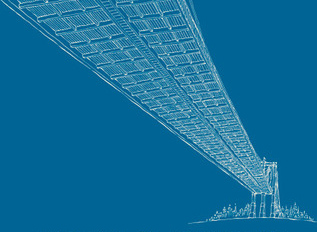
Seeking Structure
Every work of fiction is organised somehow – and the best of them are more profoundly organised than they let on. Chapter, book, verse. There is method in the story-telling madness. Our stories rely on the human instinct for architecture. Structure is, essentially, a container for content. Think of it as a shape into which your story gets placed: a house, say, slowly being built from the foundation up. Or a tunnel. Or a skyscraper. Or a palace. Or even a moving caravan, driven forward by your characters. In fact, structure can be any number of things: you just have to make sure that it doesn’t become a hole in the ground into which we sink and expire. Some writers try to envision the structure beforehand, and they shape the story to fit the structure, but this is the fool’s way out. You should never stuff your story into a predesigned structure. There is no supermarket shelf to browse: you simply can’t buy the Ikea version with all the chapters already neatly laid out. You must become bricklayer, carpenter, plumber, designer, tenant, owner, ghost in the attic. A proper structure mirrors the content of the story it wants to tell. It feels appropriate. It respects the story. It will contain its characters and drive them forward at the same time. And it will generally achieve this most fully when it does not draw attention to itself. Structure should grow out of character and plot, which essentially means that that it grows out of language. In other words, the structure is forever in the process of being shaped. You find it as you go along. Chapter by chapter. Voice by voice. Ask yourself if it feels right to tell the story in one fell swoop, or if it should be divided into sections, or if it should have multiple voices, or even multiple styles. All these questions matter. You stumble on through the dark, trying new things all the time. Sometimes, in fact, you don’t find the structure until halfway through, or even when you’re close to being finished. That’s okay. You have to trust that it will eventually appear and that it will make sense. You will often be surprised by how mathematical the work of great writers happens to be. Don’t worry. This math is a discovered thing. They didn’t set out to be this way: they discovered it as they worked their way through. So, write and chop and change and rearrange. The harder you work, the clearer the structure will become. It will take on a shape that you recognize. You will demolish a room here, add a turret there, rearrange a staircase in the house of your story. Eventually you will have somewhere you want to dwell. Then you walk around and trim a piece here, chop a piece there and reorder, fix a few of the unruly lines, put the furniture in, open the curtains, clean the windows of all the dust. And then you will have to invite a guest to come look around your home. Never forget that the reader will not want to see the foundation, or the wiring behind the walls, or even the architectural plans. That is – and was — your work. Your secret. Your difficulty. Who wants to see the wiring anyway? Not the reader, for sure. The reader should feel comfortable in the structure you have created, be it palace or hut or boathouse. Never forget that the reader nearly always moves forward in a straight line through your structure, even if the writer skipped around in its creation or indeed its presentation. So put yourself in their shoes of your reader and look critically at your own structure. Don’t condescend. Don’t make it too easy. But don’t make it too much of a maze either. Ask yourself hard questions. Is it ambitious enough? Is it dark enough? Have you built something that nobody has ever built before? You better hope so. There is no point in suburban literature. Don’t bother mowing that old grass. No, you’ve made something new. The reader should not have to think about how structure is built, but you do. In the end, only you know the secrets. Structure is the sculpture within the stone. You chisel it into life. It will eventually find its way into the museum of good storytelling. Begin with language. The content will then shape the form.
